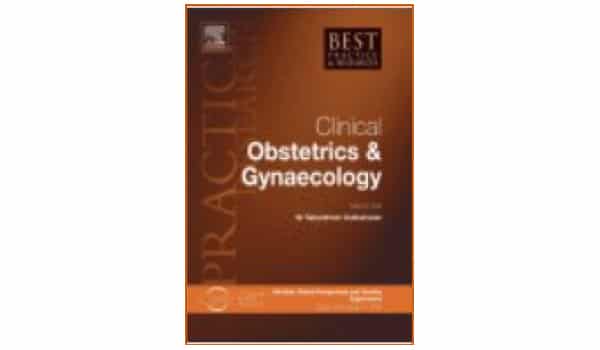
Abortion: GlobalPerspectives and Country Experiences – Special Issue
Best Practice &Research, Clinical Obstetrics & Gynaecology
January 2020, Vol. 62, pp. 1–126 All papers (open access)
Guest Editor: Iqbal HShah
Papers
– Abortion:Professional responsibility beyond safe healthcare
by Mahmoud F Fathalla Editorial pp.1–2
ThisSpecial Issue on “Abortion: global perspectives and country experiences”complements another Special Issue on “Safe abortion care.” It provides a clearmessage that the responsibility of obstetrician-gynecologists for women’shealth goes beyond delivering health care to individual patients. Ourcollective national and global responsibility is expressed in the visionstatement of the International Federation of Gynecology and Obstetrics: “Ourvision is that women of the world achieve the highest possible standard ofphysical, mental, sexual, and reproductive health and wellbeing throughouttheir lives.” We know more than others that women’s health is often compromisednot by lack of medical knowledge but by infringement on their human rights. Weshould not downgrade our profession to be just another technical medicalspecialty to deliver babies and fix pelvic organ disease.
TheOb/Gyn profession cannot play the ostrich and bury its head in the sands ofmedical technology when thousands of young women in the prime of their livesunnecessarily risk their life and health undergoing a procedure that should be,owing to modern medicine, almost completely safe. Abortion death and disabilitycould be avoided, not as much by taking costly health action but by stoppingtaking actions that restrict women’s freedom to control their own bodies. Thecase study of Canada where there are no abortion laws, presented in this issue,demonstrates that abortion can be regulated as a normal component of usualmedical care.
Thehealth profession does not have political power but has knowledge, andknowledge is power. We have the responsibility to educate the public,policymakers, and legislators about the impact of restrictive laws, policies,and regulations on women’s health. As reported in the Irish case presented inthis issue, healthcare providers can have a significant influence. Theprofession, in collaboration with others, has to stand beside and behind womenas they empower themselves. A review on the preventable pandemic of unsafeabortion concluded that the underlying causes of mortality and morbidity fromunsafe abortion currently are not blood loss and infection but, rather, apathyand disdain toward women.
ThisSpecial Issue provides obstetrician/gynecologists with evidence-basedinformation that they need to fulfill their collective responsibility at thenational and the global level. The editor-in-chief and the guest-editor are tobe complimented for selecting the appropriate themes and for assembling thisoutstanding group of international experts and their authoritativecontributions.
– Decriminalizationof abortion – A human rights imperative
by Joanna N Erdman, Rebecca J Cook Abstract andarticle pp.11–24
This chapter reviews the evolving consensus in internationalhuman rights law, first supporting the liberalization of criminalabortion laws to improve access to care and now supporting their repeal ordecriminalization as a human rights imperative to protect the health, equality,and dignity of people. This consensus is based on human rights standards or theauthoritative interpretations of U.N. and regional human rights treaties ingeneral comments and recommendations, individual communications and inquiryreports of treaty monitoring bodies, and in the thematic reports of specialrapporteurs and working groups of the U.N. and regional human rights systems.This chapter explores the reach and influence of human rightsstandards, especially how high courts in many countries reference thesestandards to hold governments accountable for the reform and repeal of criminalabortion laws.
– Global AbortionPolicies Database: A descriptive analysis of the regulatory and policyenvironment related to abortion
by Antonella F Lavelanet, Brooke Ronald Johnson Jr, BelaGanatra Abstract and article pp.25–35
The World Health Organization (WHO) Safe abortion: technical and policy guidance for health systems states that regulatory, policy, and programmatic barriers that hinder access to and timely provision of safe abortion care should be removed. Although some regulatory requirements facilitate access, where they act as barriers, they can deter women from seeking safe abortion care. We use data available in the Global Abortion Policies Database as of February 2019 to review policies related to regulatory requirements identified as access barriers in the Safe abortion guidance. We include only countries where such policies apply, i.e., where abortion is lawful on the woman’s request, with no requirement for justification and/or for one or more legal grounds. The results demonstrate the variation that exists in regulatory requirements, but little remains known about how they are implemented in practice and the implications on how women access and how providers offer safe abortion services.

– The Irish Journey:Removing the shackles of abortion restrictions in Ireland
by Maeve Taylor, Alison Spillane, Sir SabaratnamArulkumaran Abstract and article pp.36–48
In May 2018, the Irish electorate voted to remove from theConstitution one of the most restrictive abortion bans in the world. Thisreferendum followed 35 years of legal cases, human rights advocacy, feministactivism and governmental and parliamentary processes. The reframing ofabortion as an issue of women’s health rather than foetal rights was crucial tothe success of law reform efforts. The new law, enacted in 2018, provides foraccess to abortion on a woman’s request up to 12 weeks of pregnancy and insituations of risk to the life or of serious harm to the health of the pregnantwoman and fatal foetal anomaly thereafter. Abortion is now broadly accessiblein Ireland; however, continued advocacy is needed to ensure that the statemeets international human rights standards and that access to abortion care andabortion rights is fully secured within the law.
VISUAL:ARC March for Choice, 2018
– When there are noabortion laws: A case study of Canada
by Dorothy Shaw, Wendy V Norman Abstract andarticle pp. 49-62
Canada decriminalized abortion, uniquely in the world, 30 years ago. We present the timeline of relevant Canadian legal, political, and policy events before and since decriminalization. We assess implications for clinical care, health service and systems decisions, health policy, and the epidemiology of abortion in the absence of criminal legislation. As the criminal abortion law was struck down, dozens of similar private member’s bills, and one government bill, have been proposed, but none were passed. Key findings include that initially Canadian provinces attempted to provide restrictive regulations and legislation, all of which have been revoked and largely replaced with supportive policies that improve equitable, accessible, state-provided abortion service. Abortion rates have been stable over 30 years since decriminalization, and a falling proportion of abortions occur late in the second trimester. Canada demonstrates that abortion care can safely and effectively be regulated as a normal component of usual medical care.

“Prohibiting abortioncriminalises me”: confronting an anti-abortion demonstration
– Twelve years afterabortion decriminalization in Mexico City: Can we still remain an island ofliberties?
by Claudia DíazOlavarrieta, Leticia Bonifaz Alfonzo, Patricio Sanhueza-Smith, Germán E Fajardo Dolci, RosalindaGuevara-Guzmán, Mónica Beatriz Aburto-Arciniega,Vivian J Phillips, AngélicaArce Cendeño, Antonio RVilla Abstract and article pp.63–78
Latin America hosts the most restrictive abortionlegislation globally. In 2007, Mexico, the second largest Catholic country inthe world, decriminalized elective abortion within the first twelveweeks of pregnancy in the capital: Mexico City (also known as Federal Districtof Mexico). Following the reform, the Mexico City Ministry of Health (MX-MOH)implemented safe and legal services. Free services are provided to Mexico Cityresidents and a sliding fee of up to $100 is applied to women from otherMexican states. Conscientious objection was addressed and included in serviceprovision guidelines. Since 2007, 18 of 32 states amended their penal codes torestrict abortion. The road toward increasing access to abortion services atthe MX-MOH included a shift from dilation and curettage (D&C)to medical abortion (MA), first with the misoprostol-alone regimen, followed bythe combined mifepristone-misoprostol regimen. Manual vacuum aspiration isoffered to out-of-state-women or to those beyond the gestational age where MAis less effective. Contraceptive uptake among abortion seekers is high (up to95% of them prefer a free method of their choice). The Legal Interruption ofPregnancy program at the MX-MOH continues to provide effective, safe, reliable,and free services. However, women from indigenous groups residing in ruralareas, those with low schooling, and adolescents with an unintended pregnancywho live in rural, urban, peri-urban districts, and at the state level areunderserved despite being legally eligible to receive abortion services.Therefore, information and services for the disadvantaged groups need to bestrengthened.
VISUAL,2 October 2019
– Providing safeabortion services: Experiences and perspectives of providers in South Africa
by Jane Harries, Deborah Constant Abstract and article pp.79–89
Despite abortion being legally available on request up toand including the gestational age of 12 weeks in South Africa, barriers toaccess remain. Barriers include provider opposition to abortion and a shortageof trained and willing providers, which has implications for access to safeabortion services. Exploring the factors that determine providers’levels of involvement in abortion services can facilitate improvementsin service provision. Providers’ conceptualizations of abortion are influencedby numerous factors, including moral and religious views, in which abortion isperceived by some as a sin, whereas others view access to safe abortions as an importantcomponent of a woman’s right to reproductive autonomy and choice. Barriers toservice provision include limited abortion and values clarificationtraining and misinterpretation of conscientious objection. Providers have difficultieswith the emotional and visual impact of second trimester abortions. There is anurgent need to address provider shortage, and abortion education and trainingneed to be included in medical and nursing curricula to ensure sustainingabortion services.
– The complex relationshipbetween contraception and abortion
by John Cleland Abstract and article pp.90–100
The incidence of abortion is determined by the incidence ofunwelcome, or unintended, pregnancies and the propensity to terminate ratherthan take them to term. Exposure to the risk of unintended pregnancy rises asthe desired family sizes fall, because fewer years of reproductive life aretaken up with desired pregnancies. Increases in contraceptive use over recentdecades have reduced the risk of unintended pregnancies, but this effect hasbeen moderated in many regions of the world by increased propensity toterminate such pregnancies. Globally, a large majority of abortions are stillthe direct consequence of non-use of any contraceptive precautions among womenor couples not wishing to conceive. Reasons for non-use vary but side effectsand health concerns figure prominently. As overall contraceptive useincreases, choice of methods becomes a more important influence on thelikelihood of unintended pregnancies and abortions. Sterilization, implants andIUDs are more effective at pregnancy prevention than methods requiring skill,discipline, memory and frequent re-supply. Effective promotion of these methods,however, is difficult once other methods have become entrenched.
– Preventing unsafeabortion: Achievements and challenges of a global FIGO initiative
by Aníbal Faúndes, Rodica Comendant, BernaDilbaz, Guyo Jaldesa, Robert Leke, Basab Mukherjee, Marina Padilla de Gil, LuisTávara, and FIGO Initiative forthe Prevention of Unsafe Abortion
Abstractand article pp.101–112
FIGO established a Working Group on the Prevention of UnsafeAbortion in 2007 and a parallel program or “Initiative”with the same name. The initiative involved 46 FIGO member societiesfrom seven regions: South-Southeast Asia, Eastern-Central Europe and CentralAsia, North Africa and Eastern Mediterranean, Eastern- Central-Southern Africa,Western-Central Africa, Central America and Caribbean, and South America. Eachsociety working in collaboration with the corresponding Ministry of Health andother agencies conducted a situational analysis and prepared a plan of actionbased on the findings. Such plans of action are continuouslymonitored by annual evaluation of the progress in the implementation atregional workshops. A substantial progress has been achieved in providing legaland safe abortion services, replacing curettage for manual vacuum aspiration ormisoprostol and introducing and expanding post-abortion contraception withemphasis on long-acting methods, such as IUDs and contraceptive implants.



